Music for the Gods
"Orpheus and Eurydice"
Ricky Ian Gordon, Composer and Libretto
Doug Varone, Director and Choreographer
Rose Theater, Frederick P. Rose Hall
Lincoln Center
New York, New York
October 7, 2005
By Nancy Dalva
copyright ©2005 by Nancy Dalva
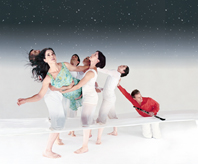 The New Visions world premiere production of “Orpheus and Eurydice,” under the auspices of Lincoln Center presents Great Performers & American Songbook, New Visions, did not add up to much as a production, but some of its disparate elements were excellent. If the intent of this affair—a song cycle of just over an hour, with the musicians incorporated into the choreography, inside a moveable set—was synthesis, it missed its mark, instead enhancing the notion, as these things usually do, that this is not merely an elusive goal, but probably a bad idea in the first place. Still, as a platform for the articulate pianism and masterful sang froid of the pianist Melvin Chen, it was entertaining. And as a showcase for the abundant vocal and physical charms of the soprano Elizabeth Futral, it was, as they say, a slam-dunk.
The New Visions world premiere production of “Orpheus and Eurydice,” under the auspices of Lincoln Center presents Great Performers & American Songbook, New Visions, did not add up to much as a production, but some of its disparate elements were excellent. If the intent of this affair—a song cycle of just over an hour, with the musicians incorporated into the choreography, inside a moveable set—was synthesis, it missed its mark, instead enhancing the notion, as these things usually do, that this is not merely an elusive goal, but probably a bad idea in the first place. Still, as a platform for the articulate pianism and masterful sang froid of the pianist Melvin Chen, it was entertaining. And as a showcase for the abundant vocal and physical charms of the soprano Elizabeth Futral, it was, as they say, a slam-dunk.
read review
Dancing Down the Walls
Zaccho Dance Theater, "Inverted States"
In the Street Festival
Choreography by Joanna Haigood
On the side of the Senator Hotel, Ellis Street, San Francisco
October 8, 2005
by Paul Parish
copyright ©2005 by Paul Parish
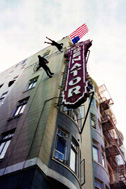 There are many explanations as to why San Francisco's Skid Row is called "the Tenderloin." My favorite, which comes from a former aide to Mayor Alioto, is that it's policeman's jargon: "a cop could live year-round on tenderloin steak from the kickbacks he'd get from all the shady businesses that needed protection." The Tenderloin is certainly placed in the ideal location for a vice zone, halfway between the financial district and the executives' homes in Pacific Heights, just north of Market.
There are many explanations as to why San Francisco's Skid Row is called "the Tenderloin." My favorite, which comes from a former aide to Mayor Alioto, is that it's policeman's jargon: "a cop could live year-round on tenderloin steak from the kickbacks he'd get from all the shady businesses that needed protection." The Tenderloin is certainly placed in the ideal location for a vice zone, halfway between the financial district and the executives' homes in Pacific Heights, just north of Market.
read review
Tackling Genocide
"Fagaala"
Compagnie Jant-Bi
Yerba Buena Center for the Arts
San Francisco, California
October 7, 2005
by Rita Felciano
copyright ©2005 by Rita Felciano
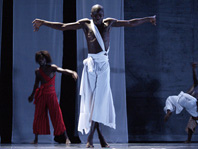 The San Francisco premiere of “Fagaala” (“Genocide”), the Senegalese Compagnie Jant-Bi’s extraordinary meditation on violence took many in its audience by surprise. Choreographed in a style that incorporated traditional African dance with Bhuto and other more contemporary vocabularies, the work was born after its choreographer Germaine Acogny’s encounter with a fictionalized account of the genocide in Rwanda, “Murambi, le livre des ossements” (“the Book of Bones”). As they popped up, the work’s most familiar elements—African style dances with their multi-rhythmic attacks, syncopations between upper and lower body and interplaying isolations—received lusty cheers. It was but slowly that the recognition seeped in that these dancers did not celebrate community, the joyous expression of togetherness that we are use to see in African dance. The steps may have looked familiar, but the energy that generated them was altogether different. These were dances of lashing out, of a desperation induced by irrational forces over which its practitioners seemed to have little control. These people were dancing about madness, about pain, about isolation—not community.
The San Francisco premiere of “Fagaala” (“Genocide”), the Senegalese Compagnie Jant-Bi’s extraordinary meditation on violence took many in its audience by surprise. Choreographed in a style that incorporated traditional African dance with Bhuto and other more contemporary vocabularies, the work was born after its choreographer Germaine Acogny’s encounter with a fictionalized account of the genocide in Rwanda, “Murambi, le livre des ossements” (“the Book of Bones”). As they popped up, the work’s most familiar elements—African style dances with their multi-rhythmic attacks, syncopations between upper and lower body and interplaying isolations—received lusty cheers. It was but slowly that the recognition seeped in that these dancers did not celebrate community, the joyous expression of togetherness that we are use to see in African dance. The steps may have looked familiar, but the energy that generated them was altogether different. These were dances of lashing out, of a desperation induced by irrational forces over which its practitioners seemed to have little control. These people were dancing about madness, about pain, about isolation—not community.
read review
Dancing in the Dark
"Handsome Blue Sky"
Ko Morobushi
New York Butoh Festival
Japan Society
New York, NY
October 6, 2005
by Tom Phillips
copyright ©2005 by Tom Phillips
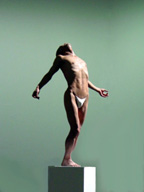 Butoh is the “dance of utter darkness,” the extreme antidote to Japan’s relentlessly cheery, brightly lit mass culture. It’s not a pretty sight, but it’s not meant to be.
Butoh is the “dance of utter darkness,” the extreme antidote to Japan’s relentlessly cheery, brightly lit mass culture. It’s not a pretty sight, but it’s not meant to be.
Butoh master Ko Morobushi’s “Handsome Blue Sky,” which opened the New York Butoh Festival at Japan Society last week, opens with a single light shining on the soles of two feet. They belong to a black-clad man facing rear, lying crumpled on his face. Slowly the feet come to life; the toes scrunch under and struggle to push upward. After a couple of minutes the feet start to look like two potatoes with tiny legs, dancing clumsily. Then suddenly, Morobushi flips over, whirls around and slaps the floor, and fixes the audience with a stare of pure horror. Good morning!
read review
Awkward Dancing from Austin
"One/The Body's Grace", "Ashes", "Desire and Three Movements"
Ballet Austin
Joyce Theater
New York, NY
October 6, 2005
by Susan Reiter
copyright ©2005 by Susan Reiter
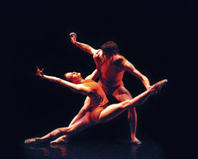 There is an awkwardness to the titles of two of the three ballets, all by artistic director Stephen Mills, that Ballet Austin brought to the Joyce Theater, and too often a comparable awkwardness to the choreography. Mills certainly choreographs with fluency, and his ballets are rich, even overstuffed, with movement ideas. But time and again a lift or a combination of steps came across as a clever idea straining to find itself in execution. And the problem did not appear to be the dancers' skill; the 20 company members were appealing and capable, if not strikingly individual—at least not as presented in these ballets. It just seemed that Mills would try to set an overly intricate phrase or a combination very tightly to the musical line, and the dancers, in their determination to get to where they were supposed to end up, had to traverse some awkward territory along the way.
There is an awkwardness to the titles of two of the three ballets, all by artistic director Stephen Mills, that Ballet Austin brought to the Joyce Theater, and too often a comparable awkwardness to the choreography. Mills certainly choreographs with fluency, and his ballets are rich, even overstuffed, with movement ideas. But time and again a lift or a combination of steps came across as a clever idea straining to find itself in execution. And the problem did not appear to be the dancers' skill; the 20 company members were appealing and capable, if not strikingly individual—at least not as presented in these ballets. It just seemed that Mills would try to set an overly intricate phrase or a combination very tightly to the musical line, and the dancers, in their determination to get to where they were supposed to end up, had to traverse some awkward territory along the way.
read review
The Kennedy Center
Festival of China
From China, Beautiful Dancing
"Giselle," "Once Upon a Time," "Piercing the Heart," and "The Yellow River
National Ballet of China
Eisenhower Theater
The John F. Kennedy Center for the Performing Arts
Washington, DC
October 4, 2005
by Alexandra Tomalonis
copyright ©2005 by Alexandra Tomalonis
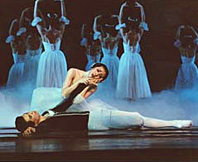 The National Ballet of China opened its one-week run at the Kennedy Center with a mixed bill headed by the second act of “Giselle”. It’s rare to see a production of a 19th century classic as lovingly staged and danced as this—will the West’s great ballet classics be preserved in the East in the Pacific Century?
The National Ballet of China opened its one-week run at the Kennedy Center with a mixed bill headed by the second act of “Giselle”. It’s rare to see a production of a 19th century classic as lovingly staged and danced as this—will the West’s great ballet classics be preserved in the East in the Pacific Century?
read review
"Raise the Red Lantern"
National Ballet of China
Eisenhower Theater, The John F. Kennedy Center for the Performing Arts
Washington, DC, USA
October 8, 2005
by George Jackson
copyright ©2005 by George Jackson
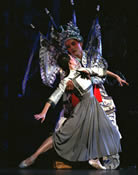 Trying to merge the compelling Western dance forms, ballet and modern, with Far Eastern traditions was a major concern of the choreographers represented during Week 1 of this month's Festival of China at the Kennedy Center. Among the dance makers' several experiments,"Raise the Red Lantern" with its large cast, operatic production values and length of three acts plus prologue and epilogue, proved to be the blockbuster. If performed on the Opera House stage, it might have seemed even more grandiose, but that's where Washington Opera is ensconced in fall. The Eisenhower's more modest proportions didn't, though, crowd unduly this ballet from the year 2001.
Trying to merge the compelling Western dance forms, ballet and modern, with Far Eastern traditions was a major concern of the choreographers represented during Week 1 of this month's Festival of China at the Kennedy Center. Among the dance makers' several experiments,"Raise the Red Lantern" with its large cast, operatic production values and length of three acts plus prologue and epilogue, proved to be the blockbuster. If performed on the Opera House stage, it might have seemed even more grandiose, but that's where Washington Opera is ensconced in fall. The Eisenhower's more modest proportions didn't, though, crowd unduly this ballet from the year 2001.
read review
City Center's
Fall for Dance Festival
Wednesday Night
Limón Dance Company; Tania Isaac Dance; Tania Perez-Salas Compañia de Danza; Aditi Mangaldas Dance Company; Houston Ballet
City Center
New York, NY
September 28, 2005
By Susan Reiter
copyright ©2005 by Susan Reiter
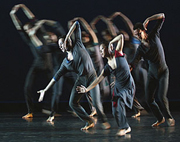 This second program of the second annual truly festive, all-embracing Fall for Dance Festival was full of visitors from near and far. The sole "home team" representative was the Limón Dance Company, which opened the two-and-a half-hour evening on a solemn, ritualistic but ultimately uplifting note with "Psalm," José Limón's powerfully communal 1967 work in the revised 2002 version. It has been seen recently during the company's Joyce Theater season, but on this occasion the dancers had much more space to fill and took advantage of it, letting Limon's breath-propelled, deeply rooted phrases unfurl and travel with their full power.
This second program of the second annual truly festive, all-embracing Fall for Dance Festival was full of visitors from near and far. The sole "home team" representative was the Limón Dance Company, which opened the two-and-a half-hour evening on a solemn, ritualistic but ultimately uplifting note with "Psalm," José Limón's powerfully communal 1967 work in the revised 2002 version. It has been seen recently during the company's Joyce Theater season, but on this occasion the dancers had much more space to fill and took advantage of it, letting Limon's breath-propelled, deeply rooted phrases unfurl and travel with their full power.
read review
Saturday Night
FALL FOR DANCE: Les Grands Ballets Canadiens de Montreal; Nai-Ni Chen; Benjamin Millepied & Company; Brenda Angiel Aerial Dance Company; Paul Taylor Dance Company
City Center
New York, NY
September 28, 2005
By Susan Reiter
copyright ©2005 by Susan Reiter
 If the idea behind programming eclectic mixed bills in this terrific festival is to open with something that grabs the audience's attention, that was certainly achieved on Saturday, when the inventive, amusing and disturbing antics of Ohad Naharin's "Minus One" began even before the house lights went down. As the audience took its seats, Anthony Bougiouris of Les Grands Ballets Canadiens de Montreal, in a black suit and white shirt, was strutting and slinking his way through spontaneous-looking, but deftly timed, dancing to mambo and cha-cha music. His movement was expansive but always just a touch off-kilter, as he threw himself off-balance and recovered in style.
If the idea behind programming eclectic mixed bills in this terrific festival is to open with something that grabs the audience's attention, that was certainly achieved on Saturday, when the inventive, amusing and disturbing antics of Ohad Naharin's "Minus One" began even before the house lights went down. As the audience took its seats, Anthony Bougiouris of Les Grands Ballets Canadiens de Montreal, in a black suit and white shirt, was strutting and slinking his way through spontaneous-looking, but deftly timed, dancing to mambo and cha-cha music. His movement was expansive but always just a touch off-kilter, as he threw himself off-balance and recovered in style.
read review
Sunday Night
FALL FOR DANCE: Charles Moulton, Vincent Mantsoe, Compagnie Marie Chouiinard, Yoshiko Chuma & The School of Hard Knocks, and the Joffrey Ballet
City Center
New York, NY
October 2, 2005
By Nancy Dalva
copyright ©2005 by Nancy Dalva
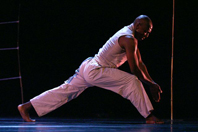 The Fall for Dance Festival was a hit. It sold out every night, people stood on line for turned-back tickets, and the houses were a mix of students, regular dance goers, and the dance community, as it likes to call itself, all enjoying the ten dollar tariff. This enterprise, now just completing it’s second year is admirable, and fun, or it should be. But closing night, not so much.
The Fall for Dance Festival was a hit. It sold out every night, people stood on line for turned-back tickets, and the houses were a mix of students, regular dance goers, and the dance community, as it likes to call itself, all enjoying the ten dollar tariff. This enterprise, now just completing it’s second year is admirable, and fun, or it should be. But closing night, not so much.
An interesting thing about that evening, given the festival’s pigeon-holing, niche programming, is how easily political correctness sorted itself into genres. On the genre scorecard, you had your equipment dance, your tribal-influenced dance, your Euro-style dance, your post-modern dance, your ballet. On the p.c. scorecard, these were your hip white choreographer, your South African choreographer, your French-Canadian choreographer, your Japanese-born choreographer, and Gerald Arpino.
read review
|
|
|